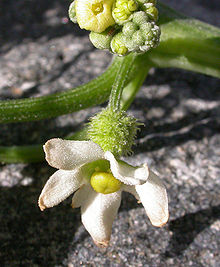Marah guadalupensis
| Marah macrocarpus | |
|---|---|
 |
|
| Scientific classification | |
| Kingdom: | Plantae |
| (unranked): | Angiosperms |
| (unranked): | Eudicots |
| (unranked): | Rosids |
| Order: | Cucurbitales |
| Family: | Cucurbitaceae |
| Genus: | Marah |
| Species: | M. macrocarpus |
| Binomial name | |
|
Marah macrocarpus Greene |
|
| Synonyms | |
|
Marah macrocarpa − (Greene) Greene |
|
Marah macrocarpa − (Greene) Greene
Marah macrocarpus or Marah macrocarpa, the Chilicothe, wild cucumber, or bigroot, is a species of the Marah genus.
The plant is native to Southern California and Baja California. Its range extends from the Transverse Ranges and Channel Islands through the Peninsular Ranges.
It grows by streams, in washes, and on slopes in chaparral and oak woodlands, at elevations up to 900 metres (3,000 ft). It will tolerate a variety of soil types and acidities, but it requires seasonally moist soil. Vines can grow in full-sun to partially shaded conditions. It emerges soon after winter rains begin, grows until late spring, and dies back completely in the heat and dryness of summer.
Marah macrocarpus has the most pubescent shoots, stems, and leaves of all the Marah species native to California - this being consistent with its range having the most xeric climate of them. Vines appear in late winter in response to increased rainfall, and can climb or scramble to a length of 6 metres (20 ft).
Vines emerge from a large, hard tuberous root which can reach several meters in length and weigh in excess of 100 kilograms (220 lb). Vines develop leaves and, particularly, flowers and fruit very quickly, often with the first nodes of the quick-growing vines containing male and female flower heads. Its leaves typically have five lobes with individual plants showing wide variation in leaf size and lobe length.
The flower can vary in colour from yellowish green to cream to white. Flowers appear soon after the vine emerges. The flowers are monoecious, that is, individual flowers are either male or female, but both sexes can be found on the same plant. Male flowers appear in open clusters while females flowers, distinguished by a swollen base, usually appear individually. The plant is self-fertile, i.e. pollen from the male flowers can fertilise the female flowers on the same plant; pollination is by insects.
...
Wikipedia
